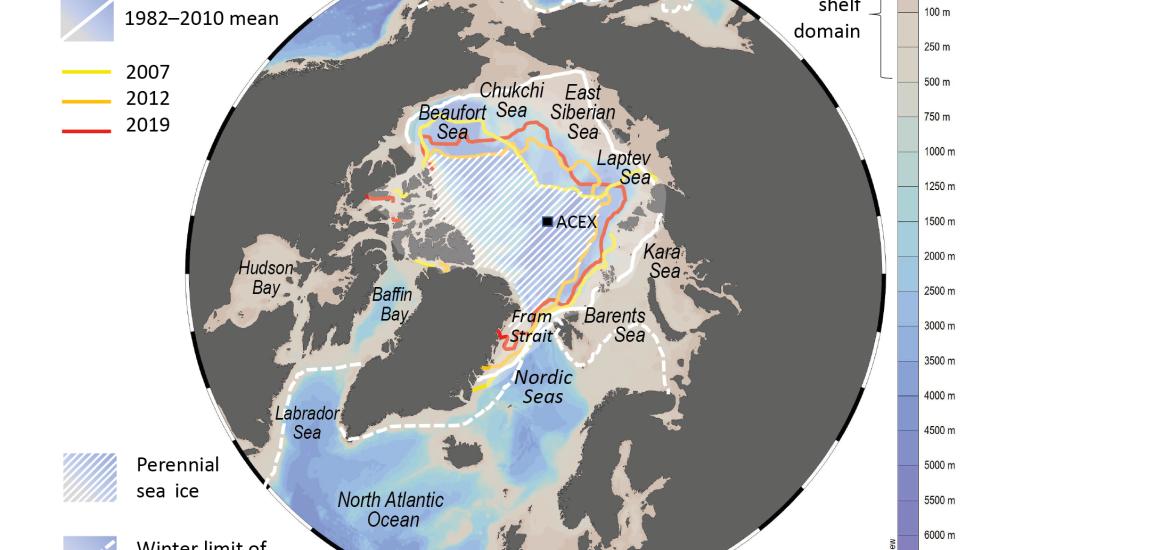- Home
- All News Overview
- Featured Article - Past Global Changes Magazine 30(2): Quaternary Arctic Sea-ice Cover: Mostly Perennial With Seasonal Openings During Interglacials

Monday, 28 November, 2022
By: Anne de Vernal and Claude Hillaire-Marcel
Available in: Past Global Changes Magazine 30(2) 94-95 2022
> Access contents of this issue
> Download this article as pdf
Following the summer insolation peak triggering the present interglacial, the Arctic Ocean shelves experienced seasonal sea ice, whereas the central basin remained mostly perennially ice-covered. During the Quaternary, sub-perennial sea ice persisted, with short summer ice-free windows during the warmer interglacials.
Perennial vs. seasonal sea ice
Sea ice plays an important role in the climate system, not only because of the ice–ocean–albedo feedback, but also because it is a freshwater reservoir that modifies the ocean stratification when it forms or melts. From this viewpoint, the presence of perennial vs. seasonal sea-ice cover is particularly critical. The perennial sea ice that survives from one year to another has a relatively simple role in regional- to basin-scale climate and ocean conditions: it is thick (>3 meters), moves slowly, maintains high albedo through the summer season, and restricts exchanges of energy and gas at the ocean–atmosphere interface (Fig. 1). Presently, the west central Arctic Ocean is the only place where perennial sea ice maintains year after year (Fig. 2).
Seasonal sea ice is more complex and more elusive, as it melts in summer, following variable patterns and time windows. This results in a sea-ice extent varying from year to year and from one region to another (e.g. Chen et al. 2016). Thus, sea-ice extent experiences large amplitude and high frequency (interannual to interdecadal) changes related to atmospheric (Cai et al. 2021) and hydrographic (e.g. Ricker et al. 2021; Belter et al. 2021) patterns. Beyond the direct impact on sea-surface temperature through a reduced albedo, the summer sea-ice melting lowers the sea-surface salinity and enhances the stratification of upper water masses, which in turn fosters freezing and sea-ice formation with the atmospheric cooling during the following fall–winter seasons.
Furthermore, seasonal, first-year sea ice is thinner than multiyear ice. It moves at a higher speed along ocean currents and is thus more efficiently exported (Kwok et al. 2013). Hence seasonal sea ice is a highly dynamic component of the Arctic climate. In addition, its export from the Arctic Ocean into the North Atlantic, via the western Fram Strait, impacts the Atlantic Meridional Overturning Circulation (AMOC). As it is a source of freshwater, it enhances the stratification of the subarctic North Atlantic and thus may lead to reduced convection. However, the winter freezing of the low salinity surface waters leads to brine production and vertical mixing. Hence, the vertical convection that occurs close to the seasonal sea-ice edge plays a role in deep water formation, which implies that shifts in the limits of winter sea ice impact the locus and strength of AMOC turning points (Bretones et al. 2022).
For all the reasons summarized above, seasonal sea ice is a critical climate parameter, but it is an elusive one, due to its high variability in time and space.
Evidence for seasonal Arctic sea ice in the early–middle Holocene
Figure 2: Map of the Arctic Ocean showing recent limits of minimum sea-ice extent in September (from Yadav et al. 2020), which might correspond to those of the mid-Holocene, and location of the Arctic Coring Expedition (ACEX) drilling site mentioned in the text. Evidence of early–middle Holocene seasonal sea ice was reported for the Chukchi, East Siberian, and Laptev seas (e.g. de Vernal et al. 2013b; Hörner et al. 2016; Stein et al. 2017).
Available in: Past Global Changes Magazine 30(2) 94-95 2022
> Access contents of this issue
> Download this article as pdf